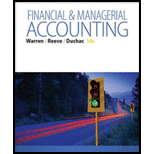
Financial & Managerial Accounting
13th Edition
ISBN: 9781285866307
Author: Carl Warren, James M. Reeve, Jonathan Duchac
Publisher: Cengage Learning
expand_more
expand_more
format_list_bulleted
Question
Chapter 12, Problem 12.5CP
1.
To determine
Earnings per share (EPS): It refers to the share of earnings earned by the shareholder on each owned. The formula to calculate the earnings per share is as follows:
To Prepare: a table indicating the expected earnings per share on the common stock under each plan.
2.
a.
To determine
To discuss: the factors that should be considered in evaluating the two plans.
b.
To determine
To explain: the plan that offers greater benefit to the present stockholders.
Expert Solution & Answer
Want to see the full answer?
Check out a sample textbook solution
Students have asked these similar questions
Given answer general Accounting
Helpp
General accounting
Chapter 12 Solutions
Financial & Managerial Accounting
Ch. 12 - Describe the two distinct obligations incurred by...Ch. 12 - Explain the meaning of each of the following terms...Ch. 12 - Prob. 3DQCh. 12 - A corporation issues 26,000,000 of 9% bonds to...Ch. 12 - Prob. 5DQCh. 12 - The following data relate to a 2,000,000, 8% bond...Ch. 12 - Prob. 7DQCh. 12 - Prob. 8DQCh. 12 - Fleeson Company needs additional funds to purchase...Ch. 12 - Prob. 10DQ
Ch. 12 - Prob. 12.1APECh. 12 - Prob. 12.1BPECh. 12 - Issuing bonds at face amount On January 1, the...Ch. 12 - Prob. 12.2BPECh. 12 - Issuing bonds at a discount On the first day of...Ch. 12 - Prob. 12.3BPECh. 12 - Prob. 12.4APECh. 12 - Prob. 12.4BPECh. 12 - Prob. 12.5APECh. 12 - Prob. 12.5BPECh. 12 - Prob. 12.6APECh. 12 - Prob. 12.6BPECh. 12 - Redemption of bonds payable A 1,500,000 bond Issue...Ch. 12 - Prob. 12.7BPECh. 12 - Prob. 12.8APECh. 12 - Prob. 12.8BPECh. 12 - Prob. 12.9APECh. 12 - Prob. 12.9BPECh. 12 - Prob. 12.1EXCh. 12 - Prob. 12.2EXCh. 12 - Prob. 12.3EXCh. 12 - Prob. 12.4EXCh. 12 - Prob. 12.5EXCh. 12 - Prob. 12.6EXCh. 12 - Prob. 12.7EXCh. 12 - Entries for issuing and calling bonds; loss Adele...Ch. 12 - Entries for issuing and calling bonds; gain Emil...Ch. 12 - Entries for installment note transactions On the...Ch. 12 - Prob. 12.11EXCh. 12 - Entries for installment note transactions On...Ch. 12 - Prob. 12.13EXCh. 12 - Prob. 12.14EXCh. 12 - Prob. 12.15EXCh. 12 - Prob. 12.16EXCh. 12 - Present value of amounts due Tommy John is going...Ch. 12 - Present value of an annuity Determine the present...Ch. 12 - Prob. 12.19EXCh. 12 - Prob. 12.20EXCh. 12 - Prob. 12.21EXCh. 12 - Prob. 12.22EXCh. 12 - Amortize discount by interest method On the first...Ch. 12 - Prob. 12.24EXCh. 12 - Prob. 12.25EXCh. 12 - Prob. 12.26EXCh. 12 - Prob. 12.1APRCh. 12 - Prob. 12.2APRCh. 12 - Bond premium, entries for bonds payable...Ch. 12 - Prob. 12.4APRCh. 12 - Prob. 12.5APRCh. 12 - Prob. 12.6APRCh. 12 - Prob. 12.1BPRCh. 12 - Prob. 12.2BPRCh. 12 - Prob. 12.3BPRCh. 12 - Prob. 12.4BPRCh. 12 - Prob. 12.5BPRCh. 12 - Prob. 12.6BPRCh. 12 - Prob. 12.1CPCh. 12 - Prob. 12.2CPCh. 12 - Prob. 12.3CPCh. 12 - Preferred stock vs. bonds Xentec Inc. has decided...Ch. 12 - Prob. 12.5CPCh. 12 - Prob. 12.6CP
Knowledge Booster
Learn more about
Need a deep-dive on the concept behind this application? Look no further. Learn more about this topic, accounting and related others by exploring similar questions and additional content below.Similar questions
arrow_back_ios
SEE MORE QUESTIONS
arrow_forward_ios
Recommended textbooks for you
 Financial AccountingAccountingISBN:9781337272124Author:Carl Warren, James M. Reeve, Jonathan DuchacPublisher:Cengage Learning
Financial AccountingAccountingISBN:9781337272124Author:Carl Warren, James M. Reeve, Jonathan DuchacPublisher:Cengage Learning Financial AccountingAccountingISBN:9781305088436Author:Carl Warren, Jim Reeve, Jonathan DuchacPublisher:Cengage Learning
Financial AccountingAccountingISBN:9781305088436Author:Carl Warren, Jim Reeve, Jonathan DuchacPublisher:Cengage Learning EBK CONTEMPORARY FINANCIAL MANAGEMENTFinanceISBN:9781337514835Author:MOYERPublisher:CENGAGE LEARNING - CONSIGNMENT
EBK CONTEMPORARY FINANCIAL MANAGEMENTFinanceISBN:9781337514835Author:MOYERPublisher:CENGAGE LEARNING - CONSIGNMENT Financial Reporting, Financial Statement Analysis...FinanceISBN:9781285190907Author:James M. Wahlen, Stephen P. Baginski, Mark BradshawPublisher:Cengage Learning
Financial Reporting, Financial Statement Analysis...FinanceISBN:9781285190907Author:James M. Wahlen, Stephen P. Baginski, Mark BradshawPublisher:Cengage Learning

Financial Accounting
Accounting
ISBN:9781337272124
Author:Carl Warren, James M. Reeve, Jonathan Duchac
Publisher:Cengage Learning

Financial Accounting
Accounting
ISBN:9781305088436
Author:Carl Warren, Jim Reeve, Jonathan Duchac
Publisher:Cengage Learning

EBK CONTEMPORARY FINANCIAL MANAGEMENT
Finance
ISBN:9781337514835
Author:MOYER
Publisher:CENGAGE LEARNING - CONSIGNMENT

Financial Reporting, Financial Statement Analysis...
Finance
ISBN:9781285190907
Author:James M. Wahlen, Stephen P. Baginski, Mark Bradshaw
Publisher:Cengage Learning


Internal Rate of Return (IRR); Author: The Finance Storyteller;https://www.youtube.com/watch?v=aS8XHZ6NM3U;License: Standard Youtube License